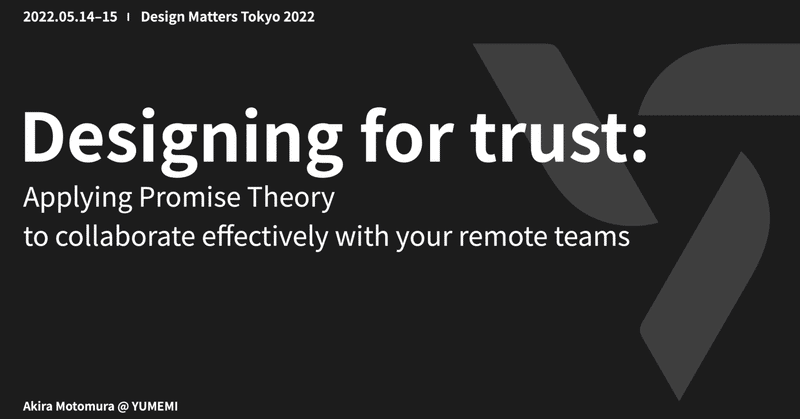
Design for trust: Applying Promise Theory to collaborate effectively with your remote teams
日本語版は、まだ作れていないのですが、@yukio_andohさんが、とても素晴らしいメモをTwitterでとってくださっているので、そちらと照らし合わせながらご覧いただけると幸いです。
#DesignMattersTokyo 信頼のためのデザイン:リモートチームと効果的にコラボレーションするためのプロミスセオリーとは Akira Motomura(UMEMI)
— Yukio Andoh (@yukio_andoh) May 15, 2022
デジタルサービスを楽しく使える形にしていっている。Ready at Hand というコンセプトで。信頼できるB2B2Cパートナーが必須。 pic.twitter.com/vKtoiYxKLN
The event defined three main themes: embrace your fuckups, designing for remote collaboration, and the Scandinavian approach to design, and I chose to talk about the second one as I've been working remotely for the past few years.
Introduction

Hi, everyone. Thank you all for having me here today, and also I would like to appreciate every member of the Design Matter team who made this wonderful event possible. I am really excited.
Let me introduce myself a little bit. My name is Akira Motomura. I am one of the board members and a lead service designer at YUMEMI. I am a bit nervous today because first all all I am an introvert, and also this is the design event whose origin is in Scandinavia; however, I've got my bachelor's degree in graphic design from the U.S., and unfortunately I've never been to any one of the Scandinavian countries.
But you know, we are here today from all over the world, and everyone here loves design. That's all that matters for us. Doesn't it?

Before I dive into today's talk. Let me introduce the company I work for. You may have never heard of YUMEMI if you are from overseas, but YUMEMI is a digital design and engineering agency that has been creating digital products and services with many famous Japanese corporations for over 20 years here in Japan.

Our primary focus is to make digital services that are useful, usable, and delightful for everyday use, aiming to create the quality, which Martin Heidegger called "ready-at-hand."

To create and deliver a "ready-at-hand" digital service, we need to work as a team with our trusting clients' members, which we call "Business and Business to Customer a.k.a. BnB2C." This co-creating mindset and collaboration model echo our brand promise: "GROW with YUMEMI".
So that's who we are. Although we have a small branch in Netherlands, our primary service currently focuses on the DX market in Japan. However, we hope to expand our reach globally in the next few years.
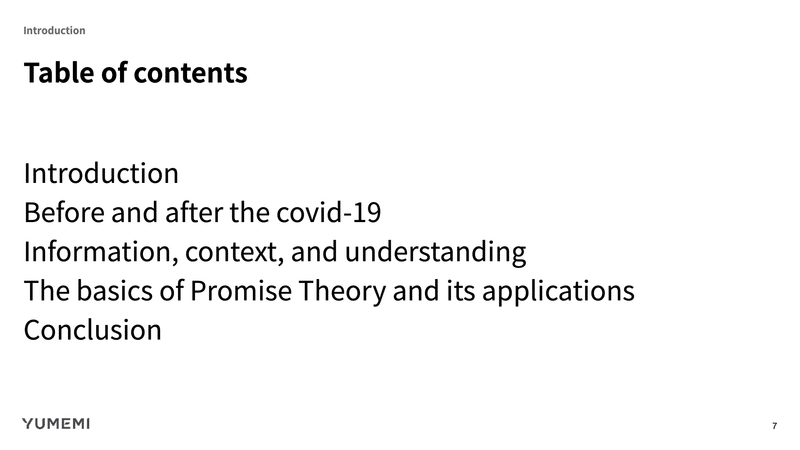
Now that I've introduced both myself and YUMEMI. I am going to start my talk. This talk focues on the topic of remote collaboration. Itconsists of 5 sections: introduction, before and after the covid-19, Information, context, and understanding, the basics of Promise Theory and its applications, and finally the conclusion. I will present some hopefully useful principles, or a lens, that I've learned to use as I've beeing working remotely for the past 2 and half years.

This is the main point of this talk.
I promise that my language is always carefully designed for us to collaborate effectively.
This is kind of an awkward phrase to put it, and after hearing talks from other speakers, I kinda wanna add the word "ethics" in here already. But this is everything that I would like you to take away from this talk. On one hand, this sounds quite simple and obvious. On the other hand, it doesn't quite tell you what you actually should do.
Hopefully, the following sections make things a bit clearer for you.
Before and after the covid-19
Many things have been changed because of the outbreak of the Covid-19.

The biggest change for me is that now I rarely have time to breathe in a day. Before the pandemic, one of my favorite things about working at the office was being able to stop by great coffee shops in town and enjoy a bit of break. Because working from home means no need of commuting to work, we can jam as many meetings as possible into our daily schedules.

In addition, our primary space of collaboration has been changed. Digital collaboration tools such as Mural, Miro, Figma, and many others alike enable us to collaborate remotely, attempting to emulate a sort of togetherness we used to have when working at the office.
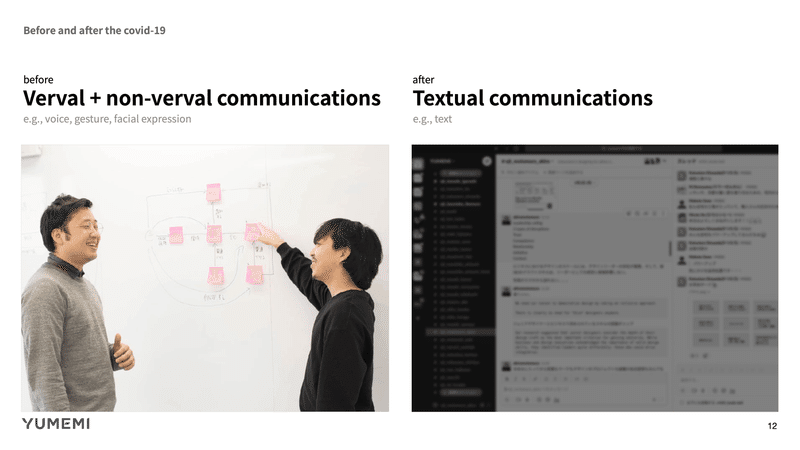
Finally, our primary means of communication have shifted from verbal and non-verbal communication to text-based one. When was the last time you sat together physically and discussed something, looking at others' eyes and faces? Have you ever thought that communicating with text sort of limits the nuances that you hope to convey?

If I try to point out the biggest change in our work environment, the answer is obvious.

It is that everything we see, hear, say, and do happens inside screens.
What this means is that we’ve completely lost any physical qualities of our work environment, which are for us, human beings, the native surroundings that have been with us since the beginning of our species. This requires us to rethink the way we work and collaborate.

So, what do we need to design to collaborate effectively with others in an environment like this?
Information, Context, and Understanding
Our communication primarily consists of information. By sharing it with others, we can have the same context and understanding.
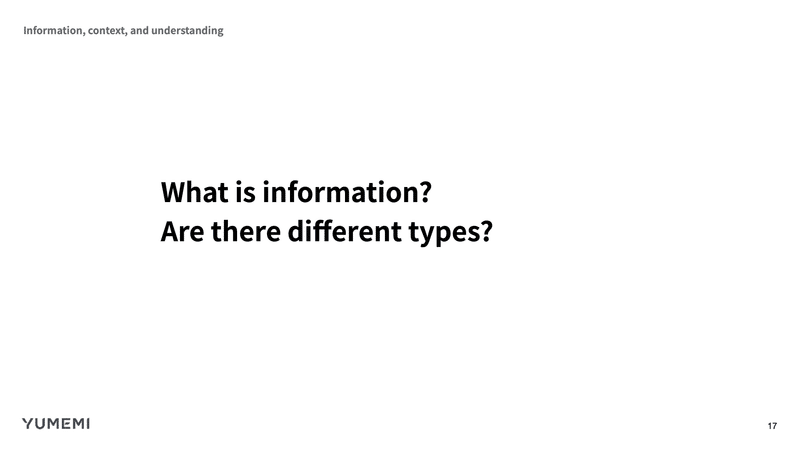
But, what is information, and are there different types?
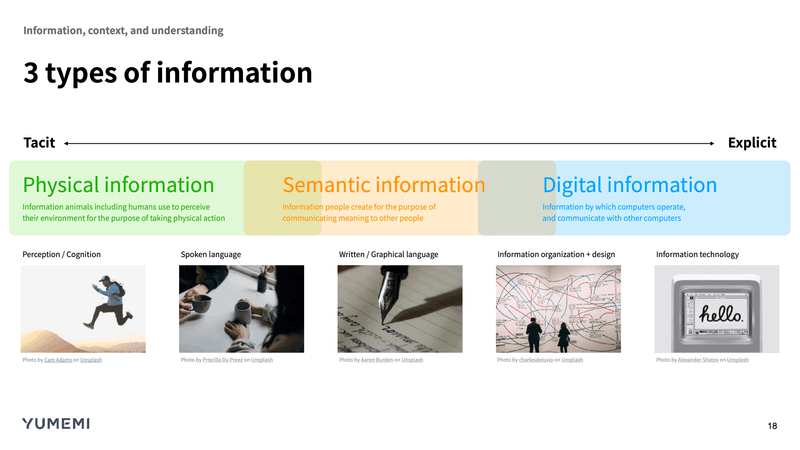
An information architect, Andrew Hinton defines three types of information in his book, "Understanding Context: Environment, Language, and Information Architecture."
Firstly, there is physical information. It is the information animals including us, human beings, use to perceive their surroundings to take physical actions such as walking and picking up a branch of a tree. This is where perception and cognition happen. This is the type of information that is most native to us as we've lived in a physical environment for thousands of years.
Secondly, there is semantic information. It is the information that people create to convey meanings to others. Language is the primary construct of semantic information, whether it's spoken, written, or graphical. This type of information enabled humans to record our histories and knowledge, greatly increasing the ability to share the same information with others.
Thirdly, there is digital information. It is the information by which computers operate and talk with other computers. This is the "information technology" kind of information that essentially caused so-called "information overload," which actually gave birth to several disciplines of design such as information architecture, information design, interaction design, data visualization, and others alike. Because this type of information needed to be as simple and explicit as possible for computers to process, it often loses a bunch of nuances we need to understand the context.
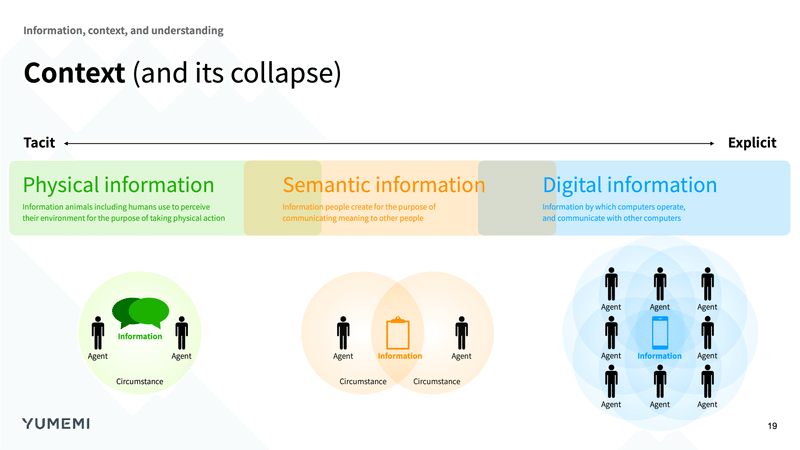
Now let's look at the relationships between context and these three types of information.
When you talk with someone else in a physical environment, you and the other person are the only agents within the same context who share the same information. There may be some miscommunications between the two; however, it is easy for them to correct the gap as they can keep talking until they reach a complete agreement on what they mean.
How about in a semantic environment? Because information to be shared may be written or codified by someone other than people trying to understand it, there can be possibly multiple interpretations generated by individuals with different contexts. However, recording-keeping objects such as papers have physical qualities that limit access to information. Thus, those different perspectives and interpretations are still somewhat manageable.
In a digital environment, all information is detached from any physical qualities which keep it from being copied unlimitedly. It is easy to understand if you imagine social media such as Twitter. Once you tweet something on your feed, it can be visible to thousands, and potentially billions of people with different perspectives and contexts, sometimes causing unintended consequences.
This is how context collapse can happen.

Now let's consider what our current environment consists of. It doesn't have any physical information; there is only semantic and digital information.

If I try to summarize some of the characteristics of our current work environment, it has
No physical qualities available
No synchronous and shared contexts
Less tacit (and unedited) information available
More explicit means of communication such as text
More individual perspectives and contexts
More explicit (and edited) information available
What this means is that more upfront designs of what we communicate with others are required; you are the one who is responsible for designing your own messages.

If we need to design our own messages, what are the things to consider?
There are of course several aspects regarding human perception and cognition.

There's the magical number seven plus minus two. Also known as Miller's law, explaining about human's cognitive capacity to process information at once.
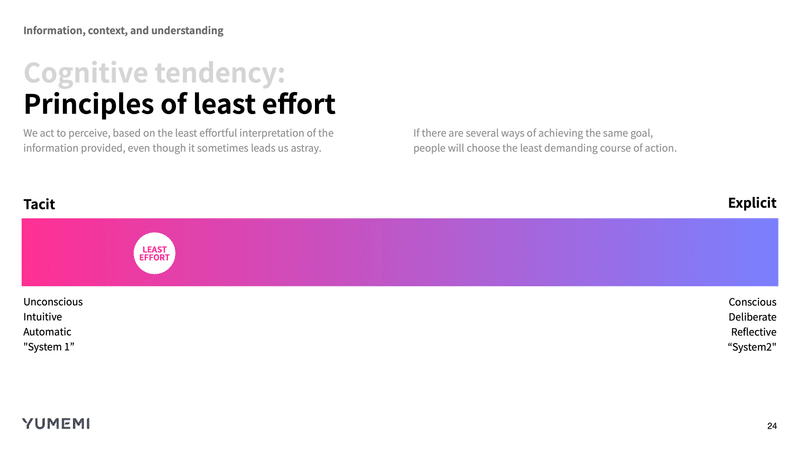
There're the principles of least effort, stating that we do things in a way that is the least effortful course of action. For example, people do not read, but scan a message.

Umwelt is the idea that different people experience and interpret differently even when looking at the same thing. For example, people may say this picture as, a vase, two people looking at each other, just black and white, and so on.
Some aspects are related to the information architecture of a space or message.

There is the concept of invariants, which was proposed by an ecological psychologist, James J. Gibson. It is the idea that people unconsciously seek properties that are stable and persistent in any environment whether it's physical or semantic to understand the context surrounding them and actions they can take. In a physical environment, it is a staircase in a house or a chair in a room. In a semantic world, they are labels in UI and definitions in a book.

In addition, we love interesting stories. It is much easier for us to understand and remember information if it follows a form of narrative than just a bunch of facts.
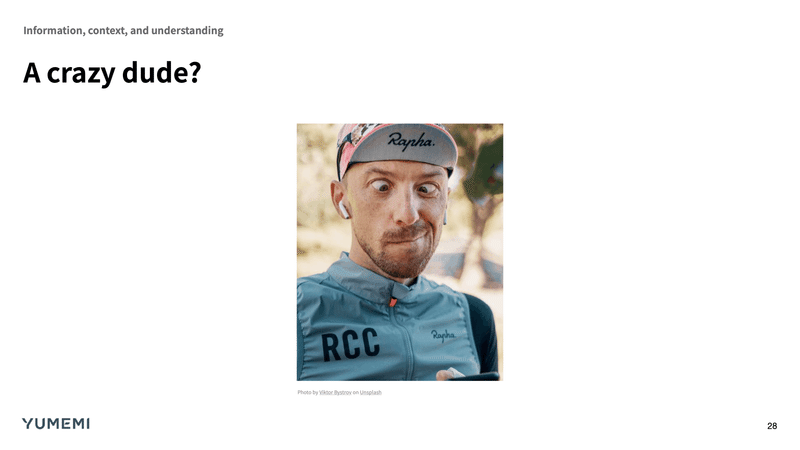
We need to understand how powerful our language is. For example, look at this picture. If he walks up to you and starts making this face, you might think he is crazy.

However, what if he said it's a staring contest before making that face. It changes the context.

As you can see, a simple description like this can dramatically change our view of the context.

Again, Andrew Hinton points out the importance of language. He calls it "language as infrastructure."
Design has traditionally been centered on objects and physical environments. There is no "language design" discipline — it's instead called "writing".
There's nothing wrong with that, but we have to come to grips with the reality that language is a more important material for design than ever, especially with the arrival of pervasive, ambient digital systems.

So how can we take advantage of this?

Let's imagine a case to design a meeting. You may tell your colleagues that there is a meeting to attend. At this point. this meeting is a black box which you and your colleagues don't know much about.

So there will be questions about the meeting's external situation. When is it? What is it about? Who else attends?

Defining those obvious but crucial properties of the meeting is a starting point to design communication. Now you and your colleagues know in what context the meeting is situated.

There are still things that are not very clear; that is, its internal structure. In the meeting, how do we proceed with our conversation?

A meeting can be structured as a form of a story: beginning, middle, and end. Dividing ups objects of the discussion into multiple agendas helps you to organize and design the meeting.
Isn't it interesting to know that in our everyday lives, there are full of things that are essentially made up of language? And we can actually see them as objects of design. And this realization has become much more important in the remote work environment.

Now, before I start talking about Promise Theory, there are questions to ask.
Can you promise to thoughtfully design your everyday communications?
Can your promises create trust?
The basics of Promise Theory and its applications

And of course, I should explain what Promise Theory is about and the reasons why we need to care.
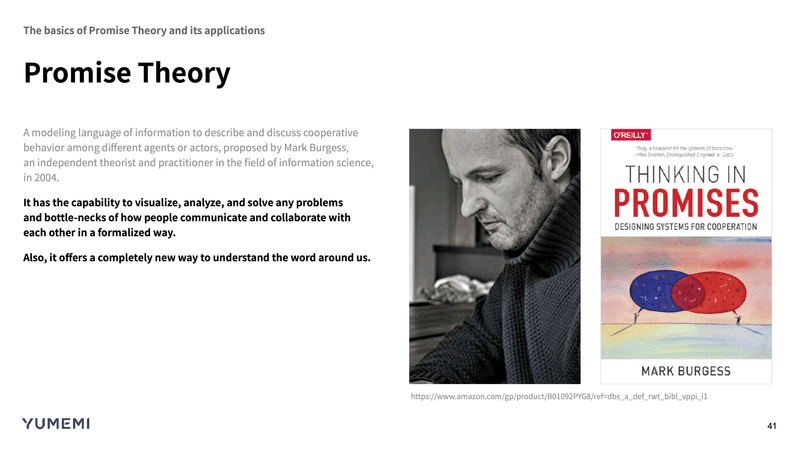
Promise Theory is a modeling language of information to describe and discuss cooperative behavior among different agents or actors including people. It was proposed by Mark Burgess in 2004. He is an independent theorist and practitioner in the field of information science.
I came across Promise Theory when looking for a way to differentiate collaborative teams' communications from that of hierarchical teams. Especially at YUMEMI, we designed our organization based on flat and networked relationships, meaning we formally don't have our bosses or subordinates. Even though I am a board member at YUMEMI, I basically don't have any authoritative powers to impose my intention on other members. We always have a conversation about what we want to accomplish, agree on what to do, and make cooperative actions. And we try to communicate in the same way with our clients so that we can build a trusting and collaborative team. That's why it was important for myself to understand the mechanism that enables a great collaboration among people, and Promise Theory offered a very clear and straightforward answer, and it gave us a new lens to see the world around us.

There are two major concepts to understand. And they are basically front and back sides of the same coin.
On one hand, there is the concept of imposition. It includes things such as hints, advice, suggestions, requests, commands, and so on. It applies to others and tells them how to behave. I assume that this is the kind of standard way of our communication in many situations. If you have kids at home, you may tell them, "clean up the room," basically imposing your own intention that the room should be clean onto your kids. No matter how hard you try to tell your kids to make the room clean, you never know whether they actually do it or not.
On the other hand, there is a concept of promise. It applies only to yourself. You define what you do and its intended outcome. It is a bottom-up way of communication. Instead of asking your kids to clean the room, you promise that the room will be clean. Since you know if you are going to keep that promise or not, you are more certain about what the end result looks like.

There are more concepts to know in Promise Theory; however, understanding the differences between imposition and promise sufficiently helps you to start modeling and analyzing your everyday conversations with your teams.
Now let's look at an example of how promises lead to cooperation and enable complex activities.

This is an example of an imposition, where one person throws a ball at another person without warning. This is what a douchebag does. Please don't do this.
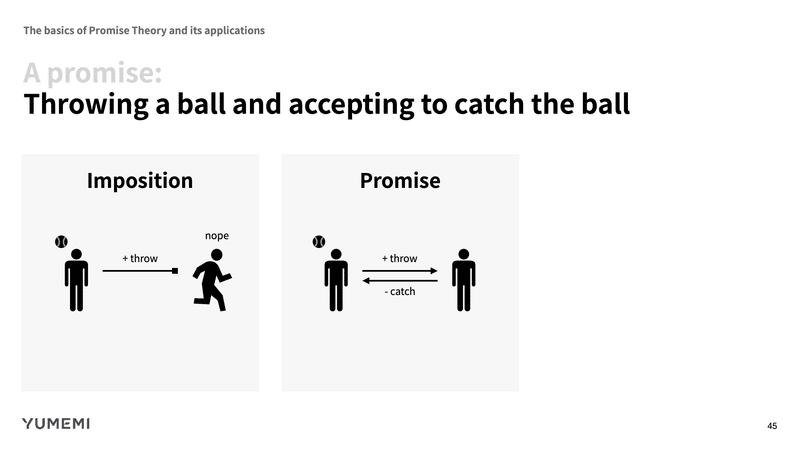
This imposition changes if the other person accepts to catch the ball. It becomes a promise-biding.

And what if they keep promising to throw and catch the ball with each other? It becomes playing catch. You can see that a simple promise can lead to the emergence of a different behavior.
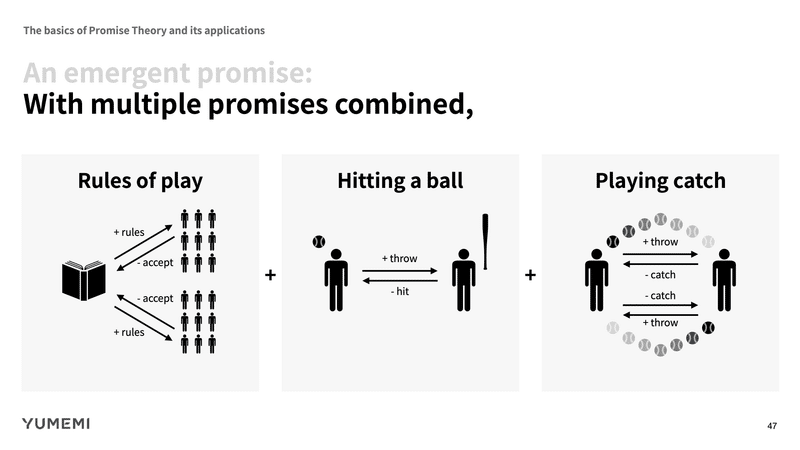
What if we combine multiple promises together, playing catch, hitting a ball, and rules of play?
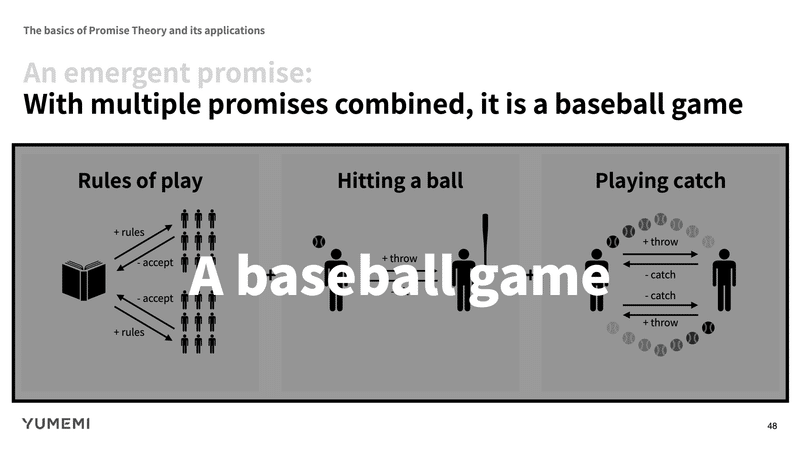
As you may have guessed, it becomes a baseball game! Promise Theory is a kind of atomic theory where multiple small promises can be combined into a single and larger promise. Promises can be modeled at many levels and details. So if you were to analyze your team's communications, start with your own interests of the analysis, and then try to expand its space to include other related promieses.

My talk's title includes the word, "trust." However, I haven't really talked about trust up until now. This is where I start talking about trust. In Promise Theory, trusting means ignoring the internal promises. In the baseball game example, there were playing catch, hitting a ball, and rules of play. If you know what a baseball game looks like and trust those internal promises as given, you can see it as a simple baseball game. It reduces the amount of information you need to care about.
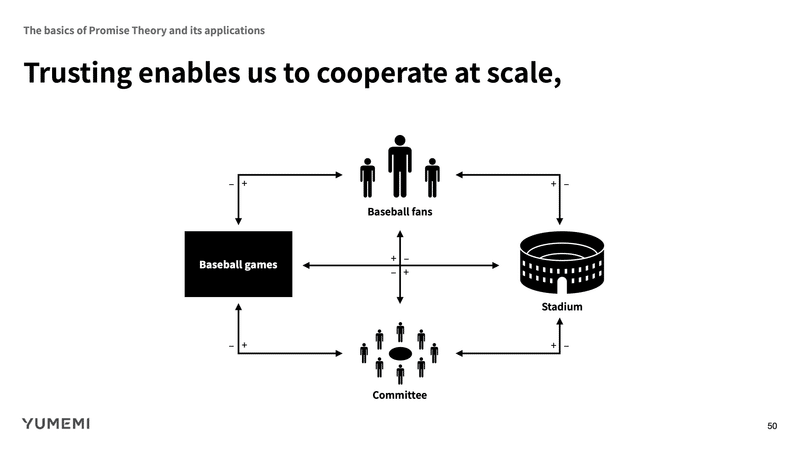
By trusting, you can combine multiple larger promises at scale,
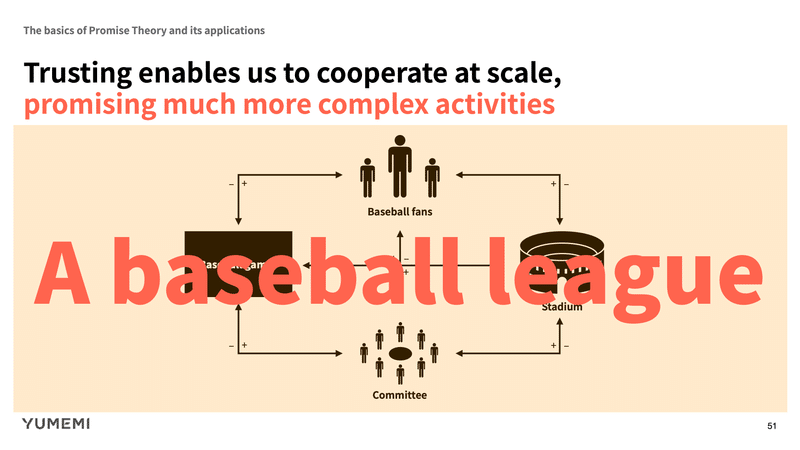
and you can promise much more complex activities. In the baseball example, it may be a baseball league.
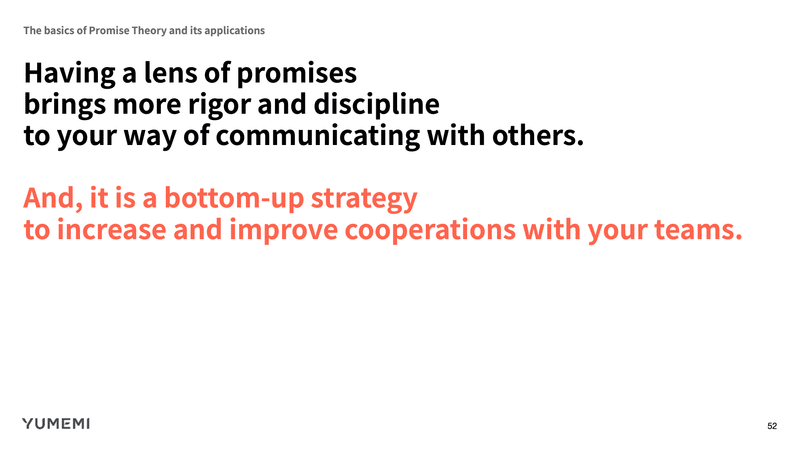
Although I use the baseball example to explain how Promise Theory works, you can apply it to many other everyday communications and activities. This presentaion itself is a kind of promise. I am promising that the inforamtion I am sharing with you has a potential usefulness for all of you; nonethelss, it is completely up to you whether you accept my proposal or not. It starts with you promising something by yourself, and if you were to collaborate with someone else, you need to be clear about what your and the other person's intended outcomes are. It requires more discipline.
And this is a bottom-up strategy to increase and improve cooperations with your teams.

Trusting is a crucial aspect when it comes to making a change. Helen Bevan, a leader of large-scale change in the English National Health Service, has identified two types of disruptors in an organization or community. Both types attempt to lead changes from the edges; however, one is being regarded as a trouble-maker who just breaks things and is not being effective and the other is being regarded as a change-maker who is being effective and making positive changes. The difference between the two is whether or not they have trusting relationships with other members of an organization or community.
What this means is that we need to build trust before we can change effectively.

Tim Kieschnick, a former UX leader at a giant healthcare company, Kaiser Permanente, recently shared steps to build trust and become a change-maker in an organization, based on his over 30-year-career, in a design podcast, called Finding Our Way, hosted by Peter Merholz and Jesse James Garrett.
The first step is to show your competence with your team members. This corresponds to the basics of Promise Theory. The first thing you need to do is to promise what you are competent at.
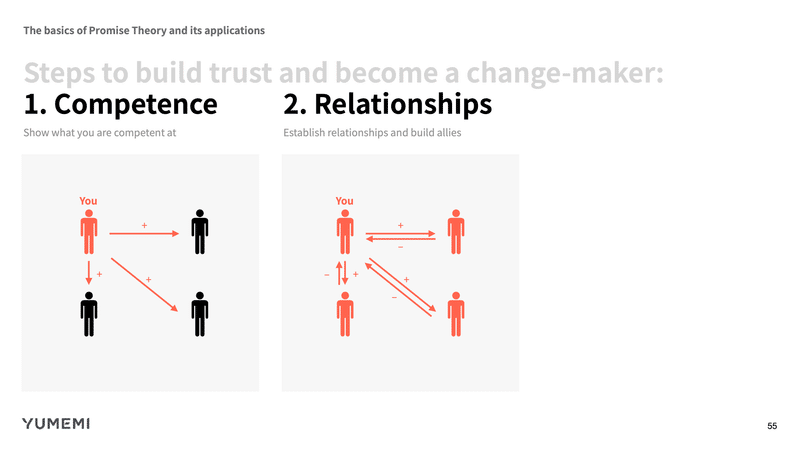
Once you show what you can do, people start accepting what you do, resulting in building relationships, or promise-bidings. One thing I should note here is that your team members also need to promise to be open and accepting about what others do in an organization and community. That creates what's called "psychological safety."
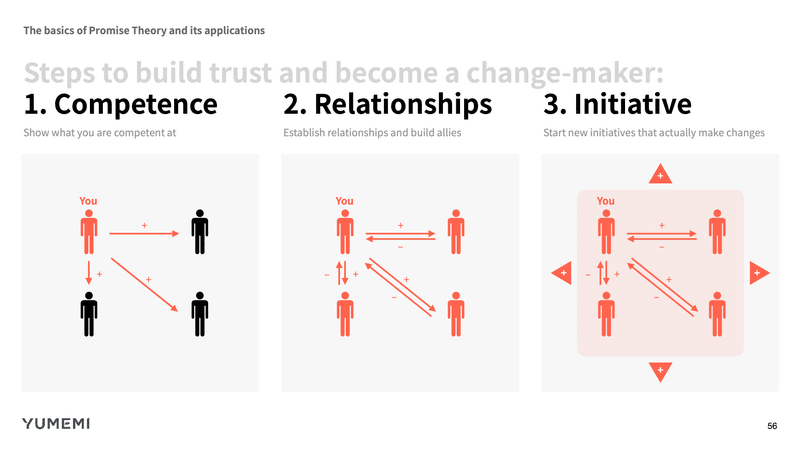
And lastly, you can take initiative. Because you've shown what you can do and built relationships up until now, most of the changes you are about to make will be understood and supported even if they end up being fuckups.
These steps seem simple and obvious. However, I assume that you have had some experiences where you had skipped the first two steps, and your killer ideas or projects got shut down or were simply ignored. I've seen many of the same cases at both our clients and YUMEMI. We need to keep telling ourselves that if we want to make positive changes, we need to build trust first. Particularly in a remote environment, your actions are invisible to others until you make them explicit.
Conclusion

To summarize, in a remote environment,
Everything happens inside screens, offering only semantics and digital information.
Deliberately designing every message you make is ever more imperative as language is the primary construct of the semantic and digital context.
Promising to design your everyday language enables you to build trust with your peers and collaborate more effectively.
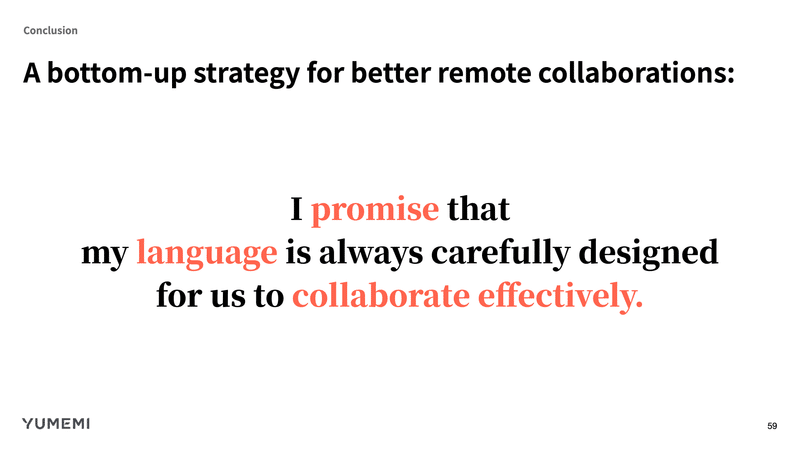
So again this is a bottom-up strategy that you start by yourself for better remote collaborations:
I promise that my language is always carefully designed for us to collaborate effectively (and potentially in an ethical and humane way).
Thanks for listening.
References
[1]
Andrew Hinton. Understanding Context: Environment, Language, and Information Architecture. O'Reilly Media. 2014.
[2]
George A. Miller. "The Magical Number Seven, Plus or Minus Two: Some Limits on Our Capacity for Processing Information.” 1956.
https://tinyurl.com/y2t6bwkc
[3]
Helen Bevan and Steve Fairman. “E The new era of thinking and practice in change and transformation: A call to action for leaders of health and care.” 2014.
https://www.england.nhs.uk/improvement-hub/wp-content/uploads/sites/44/2018/09/Change-and-Transformation-White-Paper.pdf
[4]
James J. Gibson. The Ecological Approach to Visual Perception. Psychology Press. 1986.
[5]
Mark Burgess. Thinking in Promises: Designing Systems for Cooperation. O'Reilly Media. 2015.
[6]
Mark Burgess. “3. Promise Theory - Scaling cooperation with modularity and trust (part 3).” YouTube. 2017.
[7]
Peter Merholz and Jesse James Garrett. “28: The Leadership Ceiling (ft. Tim Kieschnick).” Apple Podcast. 2022.
基本的に今後も記事は無料で公開していきます。今後もデザインに関する様々な書籍やその他の参考文献を購入したいと考えておりますので、もしもご支援いただける方がいらっしゃいましたら有り難く思います🙋♂️
